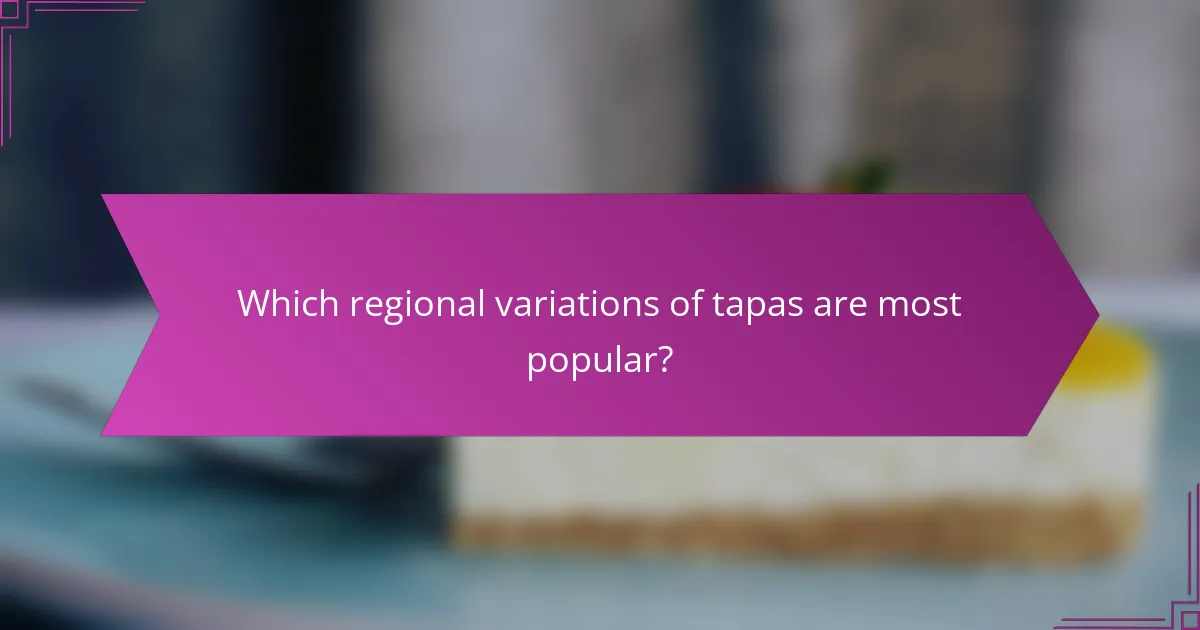Discover the rich world of traditional Spanish tapas, celebrated for their regional variations and communal dining appeal. Explore popular styles from Andalusia, Catalonia, Basque Country, and Galicia. Learn about diverse preparation methods that highlight local ingredients. Find pairing suggestions with wines and beverages that enhance the flavors of these small dishes.

What are the essential characteristics of traditional Spanish tapas?
Traditional Spanish tapas are characterized by their variety, regional diversity, and communal dining experience. They often include small portions of dishes such as olives, cheeses, and cured meats. Preparation methods vary by region, with some tapas being fried, grilled, or marinated. Pairing suggestions typically involve local wines or beers, enhancing the flavors of the dishes. Unique attributes include the use of fresh, seasonal ingredients and traditional recipes passed down through generations.
How do regional influences shape the types of tapas served?
Regional influences significantly shape the types of tapas served across Spain. Each region showcases local ingredients and culinary traditions, resulting in diverse flavors and preparations. For instance, Andalusian tapas often feature seafood, while Catalonia emphasizes cured meats and cheeses. Additionally, the use of spices, cooking techniques, and serving styles varies, reflecting cultural heritage. This regional diversity enhances the tapas experience, allowing for unique pairings with local wines and beers.
What common ingredients are used in Spanish tapas?
Common ingredients in Spanish tapas include olives, chorizo, cheese, seafood, and bread. These ingredients vary by region, showcasing local flavors and traditions. For example, manchego cheese is prevalent in La Mancha, while seafood is more common in coastal areas. Other popular ingredients are vegetables, such as peppers, and legumes like chickpeas, contributing to the diversity of tapas dishes.
Why are tapas considered a social dining experience?
Tapas are considered a social dining experience because they encourage sharing and conversation among diners. This communal style of eating fosters interaction, making meals more enjoyable. Different regions in Spain offer unique tapas, such as patatas bravas from Madrid or pintxos from the Basque Country, enriching the social aspect through diverse flavors. Pairing tapas with local wines enhances the experience, as it invites exploration of regional culinary traditions.

Which regional variations of tapas are most popular?
The most popular regional variations of tapas include Andalusian, Catalan, Basque, and Galician styles. Each region showcases unique ingredients and preparation methods.
Andalusian tapas often feature seafood, such as fried fish and shrimp. Catalan tapas, like pa amb tomàquet, highlight bread with tomato and olive oil. Basque pintxos are small snacks served on skewers, emphasizing local meats and cheeses. Galician tapas, including pulpo a la gallega, showcase octopus seasoned with paprika.
These variations reflect the diverse culinary traditions across Spain, enhancing the tapas experience.
What distinguishes Andalusian tapas from those in Catalonia?
Andalusian tapas are often more varied and richer in flavors compared to those in Catalonia, which tend to be simpler and focus on fewer ingredients. Andalusian tapas frequently include seafood, cured meats, and fried items, showcasing the region’s coastal influences. In contrast, Catalonian tapas emphasize fresh vegetables, cheeses, and unique sauces like romesco. Both regions highlight local ingredients, but the preparation methods and flavor profiles distinctly set them apart.
How do Basque pintxos differ from traditional tapas?
Basque pintxos differ from traditional tapas in their presentation and preparation. Pintxos are typically served on skewers or toothpicks, emphasizing bite-sized portions. In contrast, tapas can vary widely in size and style, often served as small plates.
Pintxos showcase a variety of ingredients, frequently highlighting local seafood and meats, while traditional tapas may include a broader range of dishes, including vegetables and cheeses. The communal aspect of sharing pintxos is central to Basque culture, whereas tapas can be enjoyed individually or shared.
Additionally, pintxos are often accompanied by a specific drink, such as txakoli, enhancing the overall dining experience. Traditional tapas pair with a wider selection of beverages, including wine and beer. These distinctions highlight the unique culinary identity of Basque cuisine compared to broader Spanish tapas traditions.
What unique tapas can be found in Valencia and their cultural significance?
Valencia offers unique tapas like “esgarraet,” a dish made from roasted red peppers and salted fish, and “fideuà,” a noodle-based variant of paella. These tapas reflect Valencia’s agricultural heritage and coastal influences. Esgarraet symbolizes the region’s emphasis on fresh, local ingredients, while fideuà showcases the significance of seafood in Valencian cuisine. Both dishes are often enjoyed with local wines, enhancing their cultural experience.

How are traditional Spanish tapas prepared?
Traditional Spanish tapas are prepared using a variety of ingredients and techniques that vary by region. Common preparation methods include marinating, grilling, and frying, often highlighting local produce. For example, in Andalusia, tapas may feature seafood, while in Catalonia, cured meats and cheeses are prevalent. Each region’s unique attributes influence the flavors and presentation, making tapas a diverse culinary experience. Pairing suggestions typically involve local wines or sherries, enhancing the overall dining experience.
What are the most common cooking methods for tapas?
The most common cooking methods for tapas include frying, grilling, baking, and marinating. These techniques enhance the flavors and textures of small dishes typical in Spanish cuisine.
Frying is often used for items like patatas bravas, while grilling is popular for meats and vegetables. Baking allows for the preparation of dishes like Spanish tortilla. Marinating imparts flavor to ingredients such as olives and seafood. Each method showcases regional variations and ingredients unique to Spanish culture.
How does presentation impact the dining experience of tapas?
Presentation significantly enhances the dining experience of tapas by elevating visual appeal and stimulating appetite. Thoughtful arrangement and garnishing can reflect regional variations and preparation methods, making each dish more inviting. For example, colorful ingredients and artistic plating can create a vibrant atmosphere that encourages sharing and social interaction. This visual stimulation complements the flavors and textures of traditional Spanish tapas, making the overall experience more enjoyable.
What are some traditional recipes for popular tapas dishes?
Traditional Spanish tapas include a variety of regional recipes. Popular dishes feature patatas bravas, which are fried potatoes served with spicy sauce, and gambas al ajillo, garlic shrimp sautéed in olive oil. Other favorites are tortilla española, a potato omelette, and albondigas, meatballs in tomato sauce. Each region adds unique ingredients, enhancing the traditional flavors. Pairing these dishes with local wines or sherries elevates the dining experience.

What are the best wine and beverage pairings for tapas?
The best wine and beverage pairings for tapas include a variety of options that enhance the flavors of the dishes. For example, dry sherry complements salty tapas like olives and anchovies, while a fruity red wine pairs well with meat-based dishes. White wines, such as Albariño, are excellent with seafood tapas. Cava, a sparkling wine, is versatile and works with many tapas. Lastly, a refreshing sangria can enhance the overall experience, especially with a mix of fruits.
Which wines complement specific types of tapas?
Wines that complement specific types of tapas include light whites for seafood, fruity reds for meats, and dry sherries for savory dishes. For example, Albariño pairs well with shrimp, while Tempranillo enhances the flavor of chorizo. Here are some optimal pairings:
| Tapas Type | Recommended Wine |
|———————|————————-|
| Seafood (e.g., prawns) | Albariño |
| Meat (e.g., chorizo) | Tempranillo |
| Cheese (e.g., manchego) | Rioja |
| Vegetables (e.g., peppers) | Verdejo |
| Fried (e.g., calamares) | Fino Sherry |
| Spicy (e.g., patatas bravas) | Garnacha |
How do regional beverages enhance the tapas experience?
Regional beverages significantly enhance the tapas experience by complementing flavors and creating a harmonious dining atmosphere. For example, pairing sherry with seafood tapas accentuates the dish’s freshness. Similarly, local wines, such as those from Rioja, add depth to meat-based tapas. These beverages not only elevate taste but also reflect regional culture, making the meal more immersive. Additionally, traditional drinks like vermouth or local craft beers provide unique flavor profiles that can transform the overall experience.
What are some innovative pairing suggestions for modern tapas?
Innovative pairing suggestions for modern tapas include combining traditional flavors with unexpected ingredients. For example, pair patatas bravas with a spicy aioli infused with smoked paprika. Another suggestion is to serve chorizo with honey and walnuts for a sweet and savory contrast. Additionally, consider pairing grilled octopus with a citrusy avocado salsa to enhance freshness. Finally, serve marinated olives alongside artisanal cheeses for a diverse flavor experience.

What are the common mistakes to avoid when serving or enjoying tapas?
Common mistakes to avoid when serving or enjoying tapas include overloading the table, neglecting regional pairings, and serving inappropriate beverages. Additionally, failing to consider portion sizes can lead to waste. Each region in Spain offers unique tapas that should be respected for their traditional pairings, enhancing the overall experience.
How can one create a balanced tapas platter?
To create a balanced tapas platter, include a variety of flavors, textures, and ingredients. Aim for a mix of proteins, vegetables, and breads, ensuring regional specialties are represented.
1. Choose proteins: Select items like chorizo, jamón ibérico, or seafood to add savory depth.
2. Incorporate vegetables: Include olives, roasted peppers, or marinated artichokes for freshness.
3. Add cheeses: Spanish cheeses like Manchego or Cabrales provide richness.
4. Include breads: Serve crusty bread or crackers for texture contrast.
5. Consider dips: Offer aioli or romesco to enhance flavor profiles.
6. Pair with beverages: Complement with Spanish wines or vermouth for an authentic experience.
What tips do experts recommend for hosting a tapas night?
To host a successful tapas night, focus on variety, presentation, and pairing. Include a mix of traditional Spanish tapas, such as patatas bravas, chorizo al vino, and olives, representing regional variations. Prepare dishes in advance to minimize stress. Use vibrant platters for presentation and encourage guests to share. Pair with Spanish wines or sherry to enhance flavors.
How can one explore new flavors while staying true to traditional tapas?
Exploring new flavors while staying true to traditional tapas involves incorporating regional ingredients and innovative techniques. Consider blending classic recipes with contemporary culinary styles to create unique dishes.
Experiment with local produce and spices to enhance traditional flavors. For example, using smoked paprika or saffron can add depth to classic dishes. Pairing tapas with diverse wines or craft beers can also elevate the tasting experience.
Incorporate seasonal ingredients to keep the menu fresh while honoring traditional methods. This approach not only respects the roots of tapas but also invites creativity and exploration in flavor profiles.



